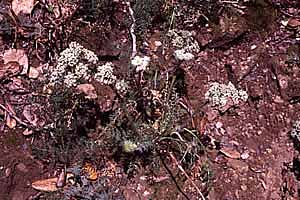 |
 |
The Apiales is a group of about 3500 to 4000 species of asterids, a large subgroup of the flowering plants. The order Apiales falls into two large groups and one smaller one. The majority of the Apiales belong either to the Araliaceae (ginseng family) or to the Apiaceae (carrot family), also known as Umbelliferae. While each of these groups has its own distinct characteristics, the two also have many things in common. Both Apiaceae and Araliaceae are widely distributed, possibly because both have many promiscuous members, so called because they can be pollinated by a variety of different organisms. Additionally, many species of both groups share the ability to self-pollinate. Members of both families also tend to have small simple flowers with one ovule (immature seed) in each locule (floral chamber).
The most distinctive feature found among the Apiales is the tendency for the flowers to be arranged in umbels. A umbel is a clustering of flowers in which each flower stalk grows from the same point at the top of the stem, an arrangement that looks much like the ribs of an umbrella turned inside-out. The flowers thus cluster into a disc, promoting their presence to pollinators as a group instead of individually.
 |
 |
Araliaceae and Apiaceae : On the left, Aralia spinosa, a small tree that is a member of the Araliaceae. On the right, Lomatium dasycarpum, the wooly-footed lomatium, an herbaceous species of Apiaceae from the San Bruno Mountains of California. Most plants in the Apiales are herbs, though some of these produce wood and there are a number of shrubs, vines, and even trees.
Araliaceae is a medium sized family with a cosmopolitan distribution. Some well-known members include ivy and ginseng, as well as many tropical and temperate herbs, shrubs, and trees. There are approximately 55 genera and 700 species in this family. Ginseng as well as other medicinal products and stimulants are some of the more popular economic uses for these plants, though other uses are made of this group, including the production of rice paper and the planting of ornamental ivies, such as Hedera helix.
Apiaceae (Umbelliferae), by contrast is a very large family indeed, with approximately 300 genera and 2,500-3,000 species. It was the first flowering plant family recognized by botanists, about the end of the 16th century, and the first group of plants to be subjected to systematic (classification) study in 1672 by Robert Morrison. The Apiaceae is primarily noted for carrots, celery, fennel, parsley, parsnips, hemlock, and many herbs. Anise, cumin, coriander, and dill are among the many spices and culinary flavorings derived from these plants. The herbs in this family are near-cosmopolitan and largely found in temperate uplands.
In addition to the Araliaceae and Apiaceae, a third group has recently been added to the Apiales. The Pittosporaceae is a medium sized family of primarily evergreen trees and shrubs, many of which are climbers. Unlike its widely distributed kin, the Pittosporaceae is restricted to the Old World tropics, and eight of its nine genera are endemic to Australia. There are only 200 to 250 species in this family, and its primary use is as ornamentals, though some Pittosporum is used for timber.
Fossils of leaves and stems are rare for the Apiales. However, the pollen record extends back to the Cretaceous. By the Paleocene, fossil pollen assignable to the Araliaceae can be found, and by the Eocene fossil pollen can be identified as belonging to the Apiaceae.


